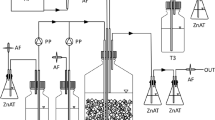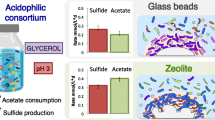Abstract
Citrate is an important component of metal processing effluents such as chemical mechanical planarization wastewaters of the semiconductor industry. Citrate can serve as an electron donor for sulfate reduction applied to promote the removal of metals, and it can also potentially be used by methanogens that coexist in anaerobic biofilms. The objective of this study was to evaluate the degradation of citrate with sulfate-reducing and methanogenic biofilms. During batch bioassays, the citrate, acetate, methane and sulfide concentrations were monitored. The results indicate that independent of the biofilm or incubation conditions used, citrate was rapidly fermented with specific rates ranging from 566 to 720 mg chemical oxygen demand (COD) consumed per gram volatile suspended solids per day. Acetate was found to be the main fermentation product of citrate degradation, which was later degraded completely under either methanogenic or sulfate reducing conditions. However, if either sulfate reduction or methanogenesis was infeasible due to specific inhibitors (2-bromoethane sulfonate), absence of sulfate or lack of adequate microorganisms in the biofilm, acetate accumulated to levels accounting for 90–100% of the citrate-COD consumed. Based on carbon balances measured in phosphate buffered bioassays, acetate, CO2 and hydrogen are the main products of citrate fermentation, with a molar ratio of 2:2:1 per mol of citrate, respectively. In bicarbonate buffered bioassays, acetogenesis of H2 and CO2 increased the yield of acetate. The results taken as a whole suggest that in anaerobic biofilm systems, citrate is metabolized via the formation of acetate as the main metabolic intermediate prior to methanogenesis or sulfate reduction. Sulfate reducing consortia must be enriched to utilize acetate as an electron donor in order to utilize the majority of the electron-equivalents in citrate.






Similar content being viewed by others
References
Antranikian G, Giffhorn F (1987) Citrate metabolism in anaerobic bacteria. FEMS Microbiol Rev 46:175–198. doi:10.1111/j.1574-6968.1987.tb02458.x
Antranikian G, Gottschalk G (1989) Phosphorylation of citrate lyase ligase in Clostridium sphenoides and regulation of anaerobic citrate metabolism in other bacteria. Biochimie 71:1029–1037. doi:10.1016/0300-9084(89)90107-7
APHA (1998) In: Clesceri LS, Greenberg AE, Eaton AD (eds) Standard methods for the examination of water and wastewater, 20th edn. American Public Health Association, Washington DC
Bhattacharya SK, Uberoi V, Dronamraju MM (1996) Interaction between acetate fed sulfate reducers and methanogens. Water Res 30:2239–2246. doi:10.1016/0043-1354(95)00238-3
Bott M (1997) Anaerobic citrate metabolism and its regulation in enterobacteria. Arch Microbiol 167:78–88. doi:10.1007/s002030050419
Bott M, Meyer M, Dimroth P (1995) Regulation of anaerobic citrate metabolism in Klebsiella pneumoniae. Mol Microbiol 18:533–546. doi:10.1111/j.1365-2958.1995.mmi_18030533.x
Breznak JA, Kane MD (1990) Microbial H2/CO2 acetogenesis in animal guts—nature and nutritional significance. FEMS Microbiol Rev 87:309–313. doi:10.1111/j.1574-6968.1990.tb04929.x
Chen JH, Huang CE (2007) Selective separation of Cu and Zn in the citric acid leachate of industrial printed wiring board sludge by D(2)EHPA-modified Amberlite XAD-4 resin. Ind Eng Chem Res 46:7231–7238. doi:10.1021/ie0616242
Colleran E, Finnegan S, Lens P (1995) Anaerobic treatment of sulfate-containing waste streams. Anton Leeuwen 67:29–46. doi:10.1007/BF00872194
Dolfing J (1988) Acetogenesis. In: Zehnder AJB (ed) Biology of anaerobic microorganisms. Wiley, New York, pp 417–468
Foucher S, Battaglia-Brunet F, Ignatiadis I, Morin D (2001) Treatment by sulfate-reducing bacteria of Chessy acid-mine drainage and metals recovery. Chem Eng Sci 56:1639–1645. doi:10.1016/S0009-2509(00)00392-4
Francis AJ, Dodge CJ, Gillow JB (1992) Biodegradation of metal citrate complexes and implications for toxic-metal mobility. Nature 356:140–142. doi:10.1038/356140a0
Golden JH, Small R, Pagan L, Shang C, Raghavan S (2000) Evaluating and treating CMP wastewater. Semicond Int 23:85–98
Gorrell TE, Uffen RL (1977) Fermentative metabolism of pyruvate by Rhodospirillum rubrum after anaerobic growth in darkness. J Bacteriol 131:533–543
Hartel U, Buckel W (1996) Fermentation of trans-aconitate via citrate, oxaloacetate, and pyruvate by Acidaminococcus fermentans. Arch Microbiol 166:342–349. doi:10.1007/s002030050393
Hugenholtz J (1993) Citrate metabolism in lactic-acid bacteria. FEMS Microbiol Rev 12:165–178. doi:10.1111/j.1574-6976.1993.tb00017.x
Hulshoff Pol LWH, Lens PNL, Weijma J, Stams AJM (2001) New developments in reactor and process technology for sulfate reduction. Water Sci Technol 44:67–76
Juang RS, Kao HC, Chen W (2006) Column removal of Ni(II) from synthetic electroplating waste water using a strong-acid resin. Separ Purif Technol 49:36–42. doi:10.1016/j.seppur.2005.08.003
Kaksonen AH (2004) The performance, kinetics and microbiology of sulfidogenic fluidized-bed reactors treating acidic metal- and sulfate-containing wastewater. PhD dissertation, Tampere University of Technology, Tampere
Lens PNL, Visser A, Janssen AJH, Hulshoff Pol LW, Lettinga G (1998) Biotechnological treatment of sulfate-rich wastewaters. Crit Rev Environ Sci Technol 28:41–88. doi:10.1080/10643389891254160
Lens P, Vallero M, Esposito G, Zandvoort M (2003) Perspectives of sulfate reducing bioreactors in environmental biotechnology. Rev Environ Sci Biotechnol 1:311–325
Liu SQ (2003) Practical implications of lactate and pyruvate metabolism by lactic acid bacteria in food and beverage fermentations. Int J Food Microbiol 83:115–131. doi:10.1016/S0168-1605(02)00366-5
Madigan MT, Martinko JM, Parker J (2003) Sulfate- and sulfur-reducing Proteobacteria. In: Madigan MT, Martinko JM, Parker J (eds) Brock biology of microorganisms. Prentice Hall, Englewood Cliffs, pp 396–399
Oude Elferink S, Visser A, Hulshoff Pol LW, Stams AJM (1994) Sulfate reduction in methanogenic bioreactors. FEMS Microbiol Rev 15:119–136
Quan ZX, La HJ, Cho YG, Hwang MH, Kim IS, Lee ST (2003) Treatment of metal-contaminated water and vertical distribution of metal precipitates in an upflow anaerobic bioreactor. Environ Technol 24:369–376
Schaab C, Schobert S, Gottscha G, Pfennig N, Giffhorn F (1972) Phototropic growth of Rhodopseudomonas gelatinosa on citrate. Accumulation and subsequent utilization of cleavage products. Z Naturforsch 27:962–967
Tabak HH, Scharp R, Burckle J, Kawahara FK, Govind R (2003) Advances in biotreatment of acid mine drainage and biorecovery of metals. 1. Metal precipitation for recovery and recycle. Biodegradation 14:423–436. doi:10.1023/A:1027332902740
Thomas RAP, Beswick AJ, Basnakova G, Moller R, Macaskie LE (2000) Growth of naturally occurring microbial isolates in metal-citrate medium and bioremediation of metal-citrate wastes. J Chem Technol Biotechnol 75:187–195. doi:10.1002/(SICI)1097-4660(200003)75:3<187::AID-JCTB206>3.0.CO;2-I
Trüper HG, Schlegel HG (1964) Sulphur metabolism in Thiorhodaceae. 1. Quantitative measurements on growing cells of Chromatium okenii. Anton Van Lee J M S 30:225–238. doi:10.1007/BF02046728
Visser A, Beeksma I, Vanderzee F, Stams AJM, Lettinga G (1993) Anaerobic degradation of volatile fatty-acids at different sulfate concentrations. Appl Microbiol Biotechnol 40:549–556
Walther R, Hippe H, Gottschalk G (1977) Citrate, a specific substrate for isolation of Clostridium sphenoides. Appl Environ Microbiol 33:955–962
Acknowledgments
This study was conducted with financial support from the Semiconductor Research Corporation/Sematech Engineering Research Center for Environmentally Benign Semiconductor Manufacturing and by a fellowship (V.G.) from the Mexican Consejo Nacional de Investigación y Ciencia (CONACyT).
Author information
Authors and Affiliations
Corresponding author
Rights and permissions
About this article
Cite this article
Gámez, V.M., Sierra-Alvarez, R., Waltz, R.J. et al. Anaerobic degradation of citrate under sulfate reducing and methanogenic conditions. Biodegradation 20, 499–510 (2009). https://doi.org/10.1007/s10532-008-9239-6
Received:
Accepted:
Published:
Issue Date:
DOI: https://doi.org/10.1007/s10532-008-9239-6




